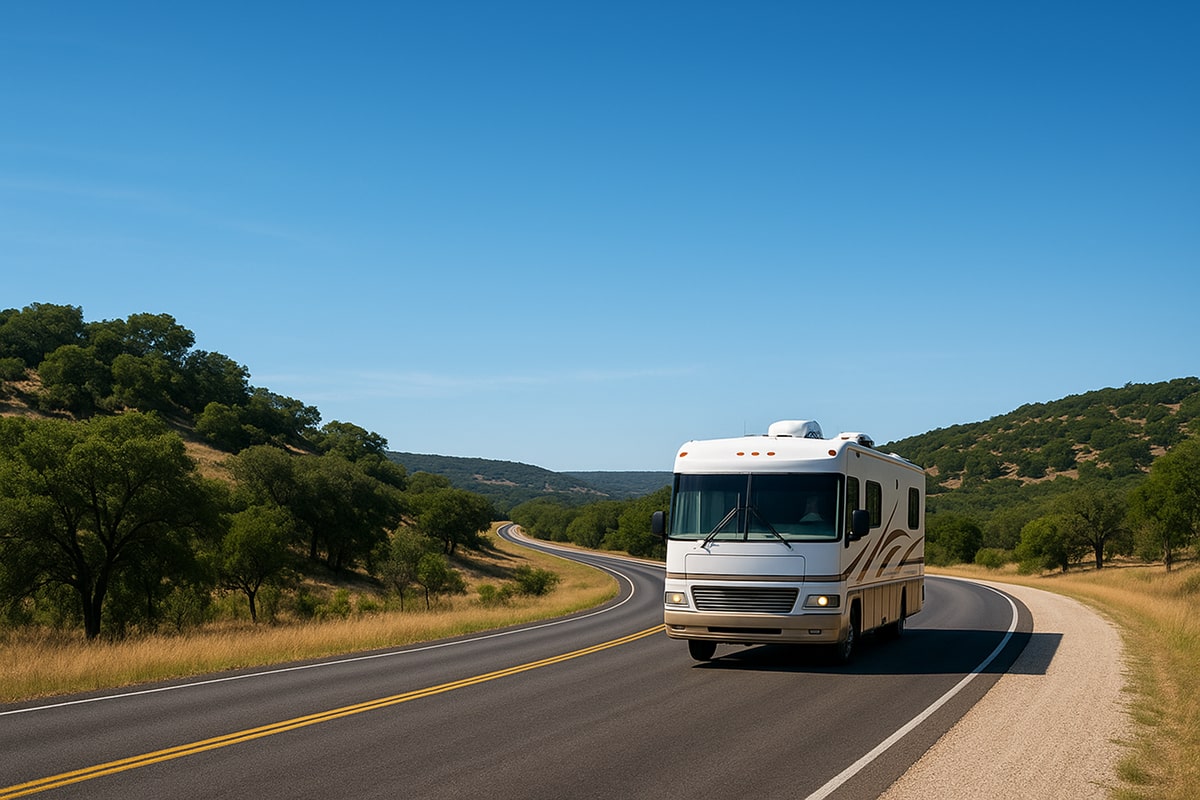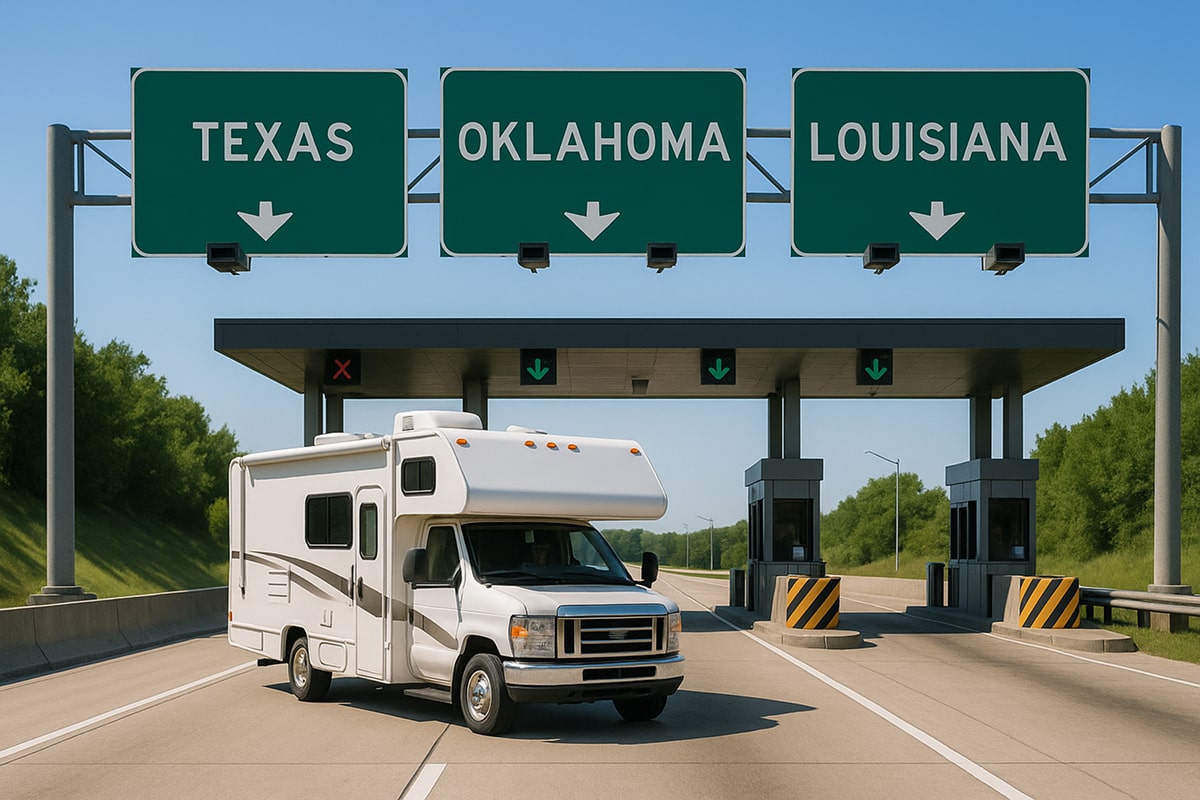
A great RV trip can cross three or four states in a single day. The law can change at each state line. That is why a quick guide saves you time, money, and stress. This article explains RV-friendly road laws by state in clear terms. You will learn the basics for length rules, toll passes, and overnight parking legality. You will also get state snapshots for Texas and nearby states to help you plan a safe route right now.
At TX RV Adventures in Houston, our team drives motorhomes and camper vans on family trips, marathons, and weekend escapes. We use the checks and tips below every season and share them with renters at pickup.
How to Use This Guide (Safety First)
-
Treat this as prep, not legal advice. Laws change.
-
Check each state’s DOT page before you depart.
-
Measure your RV: overall length, overall height (to the tallest hard point), width, and gross weight.
-
Know your trailer weight if you tow a car or a boat.
-
Know your propane setup and shutoff.
-
Set up an RV-safe GPS with your rig dimensions. Keep a truck/RV atlas as a backup.
Core Rules That Vary by State
Length, Width, Height, and Weight
-
Length: Most states cap a single motorhome at 40–45 feet. Combined length with a towed car or trailer often caps between 55–75 feet, depending on the state.
-
Width: Many states allow 8’–8’6″. Shoulders and older roads may reduce usable width.
-
Height: Common legal heights range from 13’6″ to 14′. Low bridges and older parkways can be lower.
-
Weight: Axle and gross weight limits matter on some roads and bridges. Some states may route large rigs to scales.
Action step: Put a label by the driver with measured height and length. That small card can prevent a bridge strike or a ticket.
Speed Limits, Lane Use, and Passing
-
Some states post lower speeds for vehicles that tow.
-
Right-lane rules apply on many multi-lane roads. Signs may say “Trucks/RVs keep right” or “Keep right except to pass.”
-
Mountain grades may require slow-vehicle turnouts and brake checks.
Passenger and Seat-Belt Rules
-
Most states require seat belts for all seated passengers while in motion.
-
Riding in towables (travel trailers and many fifth wheels) is often prohibited or highly restricted.
-
Child seats and booster rules still apply inside an RV.
Towing Equipment
-
Many states require brakes on trailers at 3,000 lbs GVW or lower.
-
Breakaway switch, safety chains, and sway control may be required above certain weights.
-
Double or triple tow rules vary by state and often cap combined length.
Propane Rules on Tunnels and Bridges
-
Some tunnels and bridges ban LP gas or require closed valves.
-
Look for posted signs before you enter. Use marked detours if needed.
Weather Rules: Chains and Closures
-
Mountain states may require tire chains during storms.
-
Variable speed limits and closure gates change quickly in fall and winter.
Tolls and Passes for RVs
How Tolling Works
-
Tolls often charge by axle count.
-
A motorhome with a toad or trailer can change the class and rate.
-
Transponders make billing easier but must match the plates and vehicle class.
Texas Toll Basics
-
TxTag, TollTag, and EZ TAG work across Texas and on many partner roads in nearby states.
-
Some systems in other regions, like E-ZPass, do not read Texas tags. You may need a separate transponder or pay-by-mail where allowed.
-
RV Rental tip: add the rental plate to your toll account before pickup or opt into the rental toll program if offered.
Action step: Decide on your primary transponder before the trip. Keep a small toll log in the glove box and save receipts.
Overnight Parking: What Is Legal?
Rest Areas
-
Time limits vary by state. Some allow overnight parking, others ban it.
-
“No camping” rules apply almost everywhere: no slide-outs, no grills, no awnings.
City Streets and Neighborhoods
-
City codes and HOA rules control street parking.
-
Some cities offer temporary permits; many ban overnight RV parking on streets.
-
Driveways may be allowed but can still face HOA time limits.
Retail Lots, Casinos, and Travel Centers
-
Manager permission is the key.
-
Keep a low profile. Stay one night. Do not set up outside. Pack out all trash.
Public Lands and Boondocking
-
National forests and BLM lands often allow dispersed camping with time limits (commonly 14 days).
-
Fire rules, road conditions, and gate closures can change fast.
-
Always follow Leave No Trace.
State Snapshots (Fast Facts You Can Scan)
Texas (TX)
-
Max single length: Often up to 45′ for motorhomes.
-
Max combined length: Commonly 65′.
-
Width/height: 8’–8’6″ width; up to ~14′ height on many roads.
-
Trailer brakes: Often required at ≥3,000 lbs (check current code).
-
Double/triple tow: Allowed within combined length caps.
-
Passenger in towables: Usually pickup camper only; towables restricted.
-
Rest area overnight: Allowed up to 24 hours; no camping setups.
-
Tolls: TxTag/TollTag/EZ TAG across Texas; some regional interoperability.
-
Propane/tunnels: Washburn Tunnel near Houston has LP restrictions. Close valves and follow posted limits.
Oklahoma (OK)
-
Max single/combined length: Similar to TX with combined around 65′ in many cases.
-
Width/height: 8’6″ width; ~13’6″ height typical.
-
Trailer brakes: Often ≥3,000 lbs.
-
Double/triple tow: Often allowed within length caps.
-
Passenger in towables: Usually pickup camper only.
-
Rest area overnight: Often permitted as posted.
-
Tolls: PIKEPASS (many TX tags work on some OK roads).
-
Notes: Watch wind advisories across open plains.
New Mexico (NM)
-
Max single/combined length: Motorhome up to 45′; combined often 65′.
-
Width/height: 8’–8’6″ width; ~13’6″ height typical.
-
Trailer brakes: Often ≥3,000 lbs.
-
Double/triple tow: Frequently allowed within caps.
-
Passenger in towables: Pickup camper usually permitted; towables restricted.
-
Rest area overnight: Often as posted.
-
Tolls: None statewide on most routes.
-
Notes: High-desert passes see quick weather swings; check chain rules in winter.
Colorado (CO)
-
Max single/combined length: Motorhome often 45′; combined can reach 70–75′ on certain roads.
-
Width/height: 8’6″ width; up to ~14’6″ height on major routes.
-
Trailer brakes: Often ≥3,000 lbs.
-
Double/triple tow: Restricted; highway-specific rules apply.
-
Passenger in towables: Pickup camper only in most cases.
-
Rest area overnight: Usually as posted; some areas ban overnight.
-
Tolls: E-470 and other facilities use ExpressToll/License Plate Toll; Texas tags may not read—check policy.
-
Notes: Chain laws, steep grades, brake checks, and weather holds in winter.
Louisiana (LA)
-
Max single/combined length: Motorhome up to 45′; combined often 70′.
-
Width/height: 8’6″ width; ~13’6″–14′ height on marked roads.
-
Trailer brakes: Often ≥3,000 lbs.
-
Double/triple tow: Often allowed within caps.
-
Passenger in towables: Pickup camper only.
-
Rest area overnight: Usually as posted.
-
Tolls: Select bridges and roads; check transponder acceptance.
-
Notes: Watch river-crossing wind advisories and bridge restrictions.
Arkansas (AR)
-
Max single/combined length: Motorhome around 40′; combined can reach 65′.
-
Width/height: 8’6″ width; ~13’6″ height typical.
-
Trailer brakes: Often ≥1,500–3,000 lbs (check current threshold).
-
Double/triple tow: Often allowed; confirm combined length.
-
Passenger in towables: Many bans; pickup camper generally allowed.
-
Rest area overnight: Often permitted.
-
Tolls: Very limited; plan fuel and service stops.
-
Notes: Mountain routes in the Ozarks can be tight; verify clearances.
Planning tip: For long cross-state trips, build a one-page “law sheet” for each state on your route. List your rig’s height and length at the top in bold. Add rest-area rules and any LP/tunnel notes. Keep the sheets in your driver door pocket.
Route Planning for Big Rigs
Measure Your Rig
Measure bumper-to-bumper, mirror-to-mirror, and top-to-highest point (A/C or satellite dome). Add a safety margin to the height card by the driver.
Pre-Trip Checks
-
Use an RV-safe GPS that accepts your dimensions.
-
Cross-check with a truck/RV atlas for low clearances and road bans.
-
Avoid older parkways that often restrict trailers and tall vehicles.
Fuel, Scales, and Service
-
Plan truck-friendly fuel stops with wide aprons and easy exits.
-
Mark scale locations if your combined weight runs high.
-
Save a list of 24-hour tire and mobile RV techs.
Insurance, Licensing, and Documents
Licensing
-
Most renters can drive with a standard license for Class C and many Class A units.
-
Very heavy rigs or air-brake systems may trigger added steps in your home state.
-
Keep your rental agreement, insurance card, and roadside number handy.
In-Cab Rules
-
Keep any alcohol sealed and out of reach while driving.
-
Store all substances safely and follow the stricter local rule if states differ.
Overnight Parking Etiquette (So You Don’t Get the Knock)
-
Park far from entrances and keep a low profile.
-
Do not deploy slide-outs into traffic lanes or block fire lanes.
-
No grilling, awnings, or chairs in non-camp locations.
-
Buy something if you stay at a retailer. Say thanks to the manager.
-
Leave the spot cleaner than you found it.
FAQs: RV Road Laws and Planning
Do RVs follow truck speed limits?
Sometimes. If signs list “trucks and vehicles towing,” follow that lower limit.
Are slide-outs legal at rest areas?
Rest areas allow rest, not camping. Keep slide-outs in unless you are in a large, marked spot and fully clear of traffic. Follow posted rules.
Can kids ride at the dinette without belts?
No. Seat belts keep everyone safe and are required in most states.
Do I need a special license for a Class A?
Most renters do not, but very heavy rigs can trigger extra steps in your home state. Check your DMV.
Which Texas toll tag should I use with a rental?
Use TxTag, TollTag, or EZ TAG and add the rental plate. If you travel outside the network, verify reciprocity or expect pay-by-mail.
Can I park overnight on a city street?
Some cities allow it with a permit; many ban it. Check local ordinances and any HOA rules before you park.
How TX RV Adventures Helps
-
We list each unit’s exact height and length on your booking sheet.
-
We show you how to shut off propane, use heat safely, and plan for tunnels or bridges.
-
We are available by phone to help you pick a route if a sign or gate stops you.

